Virus diseases of chrysanthemums
Over 16 virus and virus-like (viroid) diseases have been reported to infect chrysanthemums. Fortunately not all of these occur in Australia.
Four of these are considered to be economically important in Australia.
Chrysanthemum virus B (CVB)
This virus is considered to cause mild or no symptoms on most cultivars but when mixed infections of CVB and tomato aspermy cucumovirus (TAC) or chrysanthemum stunt viroid (CSVd), severe symptoms can cause loss of flower quality.
Infection of chrysanthemums with CVB may show:
- no symptoms in most cultivars
- mild leaf mottling and or vein clearing in some chrysanthemum varieties,
- reduced keeping quality of cut flowers in some varieties
- brown necrotic streaks on the florets of a few varieties
- mosaics and malformations.
It is transferred from plant to plant by aphids and by vegetative propagation from infected mother-plants.
This virus is widespread wherever chrysanthemums are grown.
Reference:
Tomato aspermy virus (TAV)
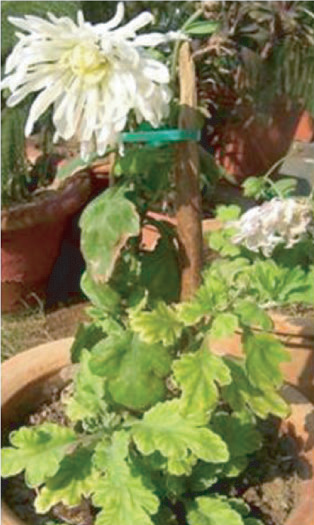
This virus causes serious losses in chrysanthemum crops and the symptoms include:
- interveinal yellowing of leaves (Figure 1)
- severe 'flower-break' or 'colour-break' in flowers
- distortion of flowers (Figures 1 and 2)
- dwarfing of the chrysanthemum plant.
Symptoms may not be expressed in the first year of infection and most cultivars show no leaf symptoms or loss of plant vigour.
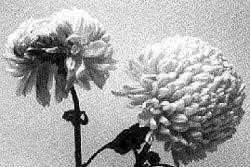
TAV is also transferred from plant to plant by aphids.
Other hosts of the virus include tomato, Canna and Lilium.
It is found in most countries where chrysanthemums are grown.
Reference:
- Description of plant viruses – Tomato aspermy virus
- Raj SK, Kumar S, Choudhari S (2007) – Identification of Tomato aspermy virus as the cause of yellow mosaic and flower deformation of chrysanthemums in India Australasian Plant Disease Notes 2:1-2
Tomato spotted wilt virus (TSWV)
Significant yield losses have been reported in Chrysanthemums.
Several strains of TSWV have been identified and symptoms in chrysanthemums depends on the cultivar.
Leaf and stem symptoms range from:
- yellow ring and line patterns
- faint mottling
- brown spotting between leaf veins
- yellowing of the veins
- stems greying and collapsing, often under the flower.
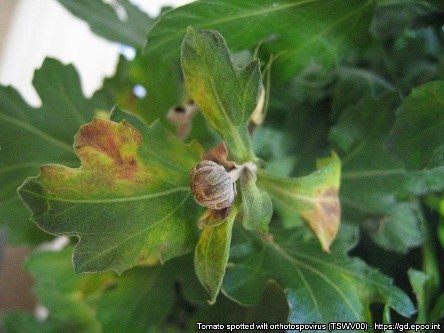
Transmission:
- TSWV is spread from plant to plant by thrips.
- It is unlikely to be seed transmitted.
TSWV has a wide host range and world-wide distribution.
References:
- Description of plant viruses — Tomato spotted wilt virus
- Wollaeger H (2016) Know the symptoms of tomato spotted wilt virus in chrysanthemum. Michigan State University Extension.
Chrysanthemum stunt viroid (CSVd)
This disease is highly infectious and can cause serious losses in chrysanthemum crops. The natural host range of CSVd includes Chrysanthemum and Petunia. CSVd is probably distributed world-wide where chrysanthemums are grown.
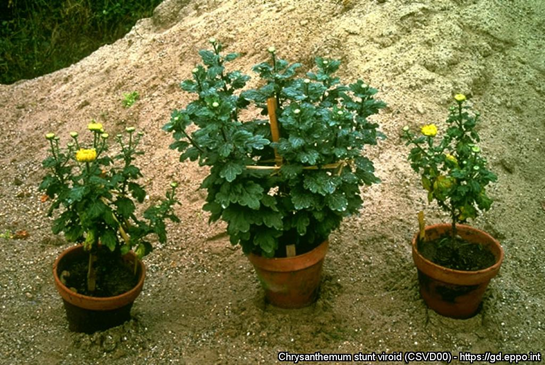
Symptoms
CSVd symptoms are variable and dependent on cultivar, light and temperature.
Infected plants:
- may be symptomless
- older susceptible cultivars may show numerous conspicuous white leaf spots, termed 'measles'.
- are reduced in size (Figure 4)
- may have smaller, pale leaves with spots or flecks (Figure 5)
- tend to flower earlier (Figure 4).
- often have smaller and distorted flowers (Figure 6)
- can show bleaching of flower colour (Figure 6)
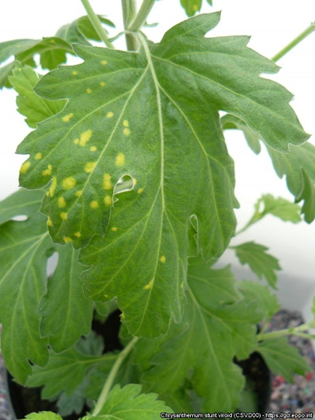
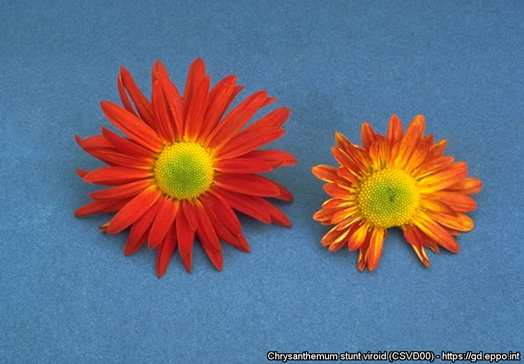
References:
- Description of plant viruses — Chrysanthemum stunt viroid
Controlling viruses and viroids
- No spray or chemical treatment will eliminate a virus or viroid from an infected plant.
- Disease control can only be achieved by use of virus-tested planting stock in conjunction with strict hygienic practices.
- The movement of insects, such as thrips and aphids, should be controlled as these can vector virus diseases.
- Propagating tools and knives must be sterilised after use.
- Avoid staff moving from areas where plants are infected to healthy stock.
- Educate staff about the effects of virus and viroid diseases and their mode of transmission.
- Washing of hands with hot soapy water before handling chrysanthemum plants helps safeguard against virus diseases that are transmitted by contact.
Reporting an unusual plant insect pest or disease
Report any unusual plant pest or disease immediately using our online reporting form or by calling the Exotic Plant Pest Hotline on 1800 084 881. Early reporting increases the chance of effective control and eradication.
Please take multiple good quality photos of the pests or damage to include in your report where possible, as this is essential for rapid pest and disease diagnosis and response.
Your report will be responded to by an experienced staff member, who may seek more information about the detection and explain next steps.
Report onlinePhoto credits
Figure 1 courtesy of Professor SK Raj.
Figure 4 courtesy of J. Dunez (FR) and EPPO.
Figure 5 courtesy of NPPO of the Netherland and EPPO.